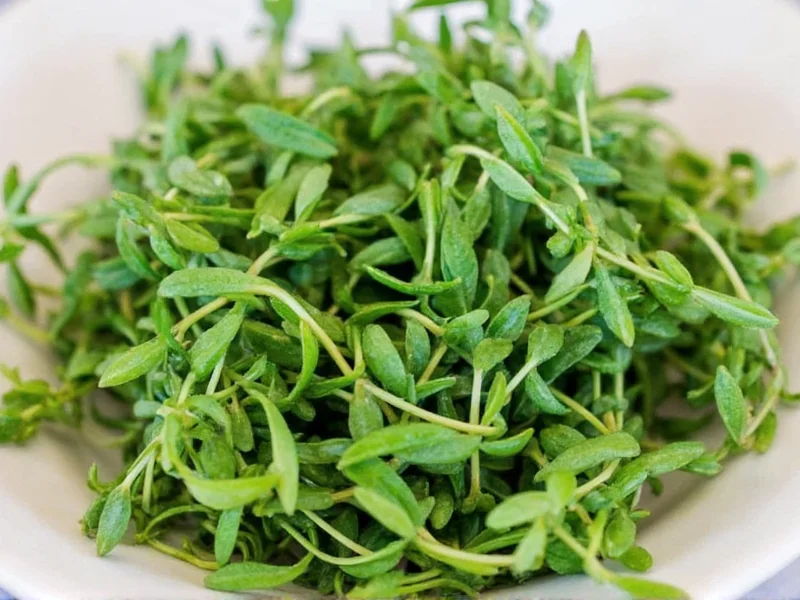Understanding thyme's flavor profile helps home cooks and professional chefs alike create balanced dishes. This versatile herb belongs to the mint family (Lamiaceae) and shares botanical relations with oregano, marjoram, and basil, though its taste remains uniquely its own. When evaluating what does fresh thyme taste like compared to dried, the fresh variety provides a more delicate, floral experience with pronounced lemon notes, while dried thyme develops deeper earthy tones with intensified herbal intensity.
Breaking Down Thyme's Flavor Components
Thyme's complex taste emerges from several distinct elements working in harmony:
| Flavor Component | Description | Intensity Level |
|---|---|---|
| Earthy | Soil-like, grounded base note reminiscent of forest floors | Moderate |
| Lemon/Citrus | Bright, refreshing top note especially prominent in fresh thyme | Mild to Moderate |
| Minty | Subtle cooling sensation from its mint family heritage | Mild |
| Peppery | Delicate spicy finish that lingers on the palate | Mild |
| Woody | More pronounced in dried thyme, adding depth and complexity | Moderate (dried), Mild (fresh) |
Fresh vs. Dried Thyme: Understanding the Taste Difference
When considering fresh thyme vs dried thyme taste difference, several key distinctions emerge. Fresh thyme leaves contain higher moisture content, which preserves volatile oils responsible for its bright citrus notes. The moment you crush a fresh sprig between your fingers, you'll notice an immediate aromatic release of lemon and floral compounds.
Dried thyme undergoes a transformation where moisture evaporates, concentrating certain compounds while diminishing others. This process intensifies the earthy, woody characteristics while reducing the bright citrus elements. Professional chefs often use ⅓ the amount of dried thyme when substituting for fresh due to this concentration effect.
Culinary Applications and Pairing Guidance
Understanding what dishes pair well with thyme elevates your cooking significantly. Thyme's moderate intensity makes it incredibly versatile across multiple cuisines:
- Proteins: Complements chicken, lamb, and fish exceptionally well, particularly when combined with garlic and lemon
- Vegetables: Enhances roasted root vegetables, mushrooms, and tomatoes
- Sauces and Stocks: Forms part of the French "bouquet garni" and essential in many braising liquids
- Herb Combinations: Works beautifully with rosemary, sage, and parsley in varying proportions
When exploring thyme vs rosemary flavor comparisons, remember that rosemary delivers a more pine-like, assertive taste that can dominate a dish, while thyme offers a more subtle background note that enhances without overwhelming. Many Mediterranean recipes use both herbs together for layered complexity.
Common Substitutions and Usage Tips
If you're wondering what can I use instead of thyme, consider these alternatives based on your specific recipe needs:
- Oregano: Provides similar earthiness with more pungency (use ¾ the amount)
- Marjoram: Offers comparable floral notes with sweeter profile (use equal amount)
- Herbes de Provence: Contains thyme plus complementary herbs (use equal amount)
- Savory: Delivers similar peppery finish with more intensity (use ½ the amount)
For optimal flavor extraction, add fresh thyme toward the end of cooking to preserve its delicate notes, while dried thyme benefits from earlier addition to allow its compounds to infuse throughout the dish. When using whole sprigs, remember that the small leaves release flavor gradually during cooking and can be removed before serving.
Understanding Thyme Varieties and Their Flavor Nuances
Not all thyme varieties taste identical. Common garden thyme (Thymus vulgaris) delivers the classic flavor profile, while lemon thyme (Thymus citriodorus) amplifies the citrus notes significantly. Caraway thyme introduces subtle anise-like qualities, and wild thyme often presents a more intense, floral character. Recognizing these variations helps when selecting thyme for specific recipes where how to describe thyme taste becomes crucial to dish success.











 浙公网安备
33010002000092号
浙公网安备
33010002000092号 浙B2-20120091-4
浙B2-20120091-4